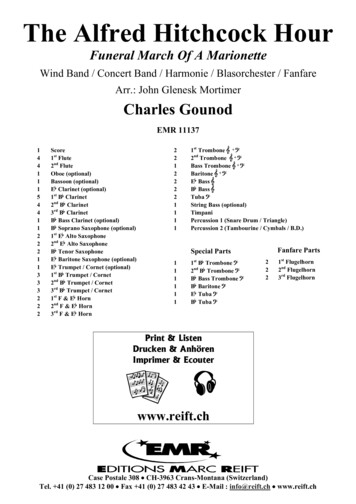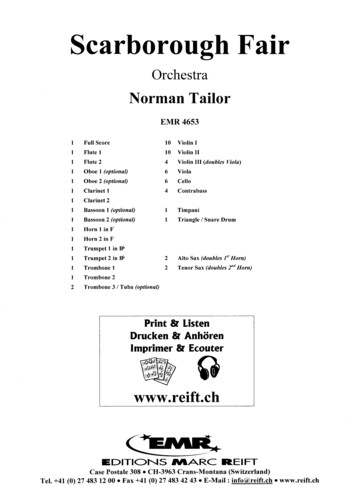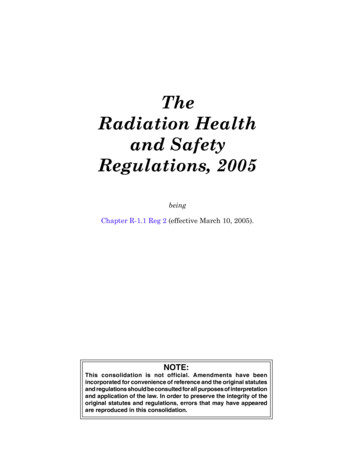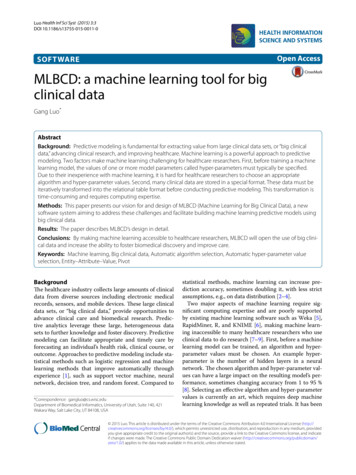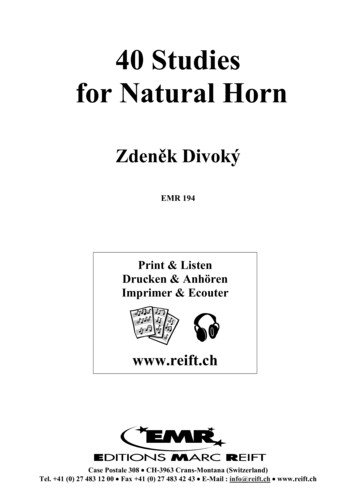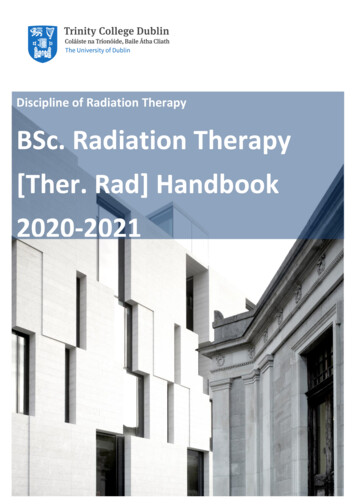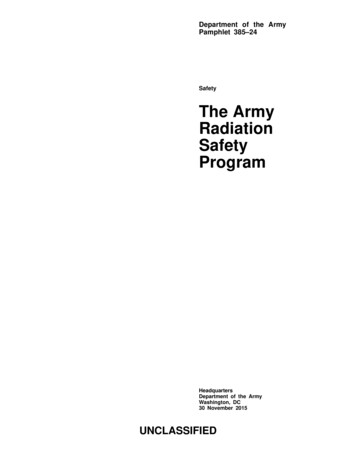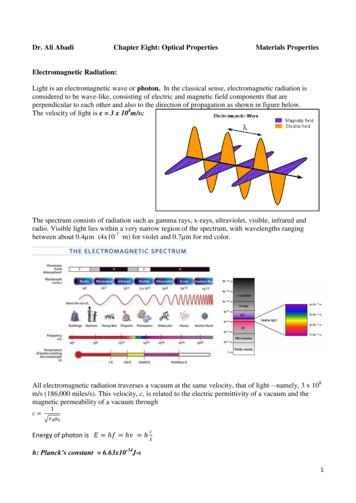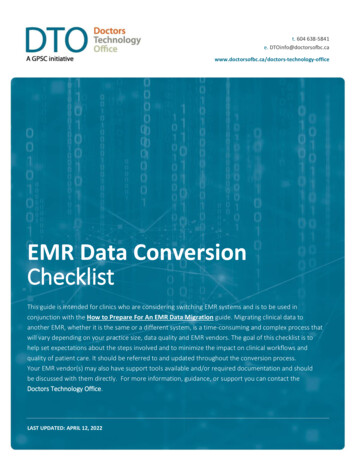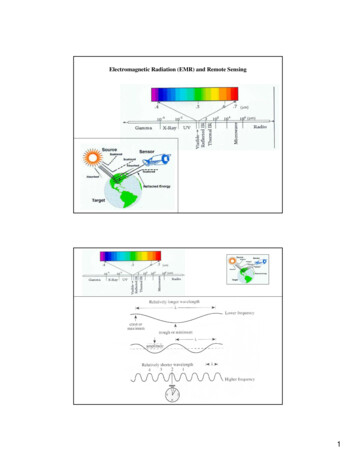
Transcription
Electromagnetic Radiation (EMR) and Remote Sensing1
AtmosphereAnything missing in between?Electromagnetic Radiation (EMR) is radiated by atomic particles at the source (the Sun), propagates through the vacuum of space at the speed of light, interacts with the Earth's atmosphere, interacts with the Earth's surface, interacts with the Earth's atmosphere once again, and finally reaches the remote sensors where it interacts withvarious optical systems and detectors.2
Atmospheric ScatteringWhen passing through the atmosphere, EMR interact with thesuspended particles, such as aerosols, and clouds. Thereforescattering process happens. Three types of atmosphericscattering are important in remote sensing considerations.Rayleigh (or molecular) Scattering:Rayleigh scattering is primarily caused by oxygen and nitrogenmolecules. The effective diameters are at least 0.1 times smallerthan the affected wavelengths.Rayleigh scattering is most influential at altitude above 4.5 km(pure atmosphere).3
Rayleigh (or molecular) Scattering:The amount of Rayleigh scattering is1 / 4As the result, invisible ultraviolet radiation is greatly affectedby Rayleigh scattering.Rayleigh scattering can be called small particle scattering.In visible light, blue wavelength at 0.4 m is scattered 5 timesas the red wavelength at 0.6 m.This explains why the clear sky appears blue. The scatteringmade blue light reach our eyes from all parts of the sky.4
Mie (or nonmolecular) Scattering:Occurs when there are sufficient particles in the atmospherethat have mean diameters from 0.1 to 10 times larger than thewavelength under consideration.Mie scattering can be called large particle scattering.The important Mie scattering agents include water vapor andtiny particles of smoke, dust, etc. The influence of the Miescattering is most affected in the lower 4.5 km of theatmosphere.Mie scattering influences longer radiation wavelengths thanRayleigh scattering.The wavelength of Mie scattering is between 4to 0.5
Nonselective scattering:Happened when the lower atmosphere contains suspendedaerosols. The aerosols should have diameters at least 10 timeslarger than the wavelengths under consideration.The important scattering agents include large particles of smoke,water vapor, water droplets, ice crystals in the clouds and fog.Nonselective scattering has impacts on almost all spectral bands.In visible wavelengths, water droplets and ice crystals scatterall wavelengths equally well so that the clouds in the sunlit skylooks white. Also large smog particles cause the color of sky togrey.6
Spectral Reflectance PropertiesHow much of EMR will be reflected depends on the nature of thematerials and which portion of the EMR is being measured.The nature of this reflected component over a range ofwavelengths is called spectral response patterns.Spectral patterns are descriptions of the degree to which energy isreflected in different regions of the spectrum.Typicalspectralreflectancecurves in theregion0.4 – 0.9 m.7
Spectral SignatureEvery natural and artificial object reflects and emits EMRover a range of wavelengths in its own chemicalcomposition and physical state.The distinctive reflectance and emission properties ofobjects are called spectral signature.Within some limited wavelength region, a particular objectwill usually exhibit a diagnostic spectral response patternsthat differs from other objects.8
It is hoped that each material on the earth would have adistinctive spectral response patterns that would allow it tobe reliably detected by visual and digital means.Finding distinctive spectral response patterns is the key tomost procedures for remote sensing image interpretation.Spectral Response CurveApril and May Spectra for P. australisand S. patensBlueGreenRedNIR0.6Reflectance (%)0.5April P. australisMay P. australisApril S. patensMay S. patensSensor h (nm)9
Spectral Response CurvesApril and May Spectra for P. australisand S. patensVioletBlueGreenRedNIRMid-IR0.6April P. australisMay P. australisApril S. patensMay S. patensSensor Design?Reflectance (%)0.50.40.30.20.10350450550650750850950Wavelength (nm)The atmosphere essentially“closes down” in certain portionsof the spectrum while“atmospheric windows” exist inother regions that transmitincident energy effectively to theground.It is within these windows thatremote sensing systems mustfunction.The combined effects ofatmospheric absorption,scattering, and reflectance reducethe amount of solar irradiancereaching the Earth’s surface.10
Atmospheric blinds:The wavelength which areBlocked by the atmosphere.Atmospheric windows:The wavelength which canpass through the atmosphere.EMR The foundation of remote sensing technology is based on themeasurement and interpretation of the patterns of EMR. EMR is a dynamic form of energy. EMR transmit cross space inthe wave form and in the speed of light. The whole range of EMR is called spectrum. EMR is characterized by wavelength and frequency. Differentwavelengths or frequencies indicates different portion of EMR. EMR interact with atmosphere. The atmosphere causessignificant absorption and/or scattering of the wavelength, suchas Rayleigh (molecular) scattering, Mie (non-molecular)scattering, and non-selective scattering. EMR also interact with the surface materials in the form ofabsorption, reflection, and transmission. Consider the reasons of interaction between EMR and theatmosphere, atmospheric windows will have to be used forremote sensor design and ground information detection.11
12
EMR The foundation of remote sensing technology is based on the measurement and interpretation of the patterns of EMR. EMR is a dynamic form of energy. EMR transmit cross space in the wave form and in the speed of light. The whole range of EMR is called spectrum. EMR is characterized by wavelength and frequency. Different
